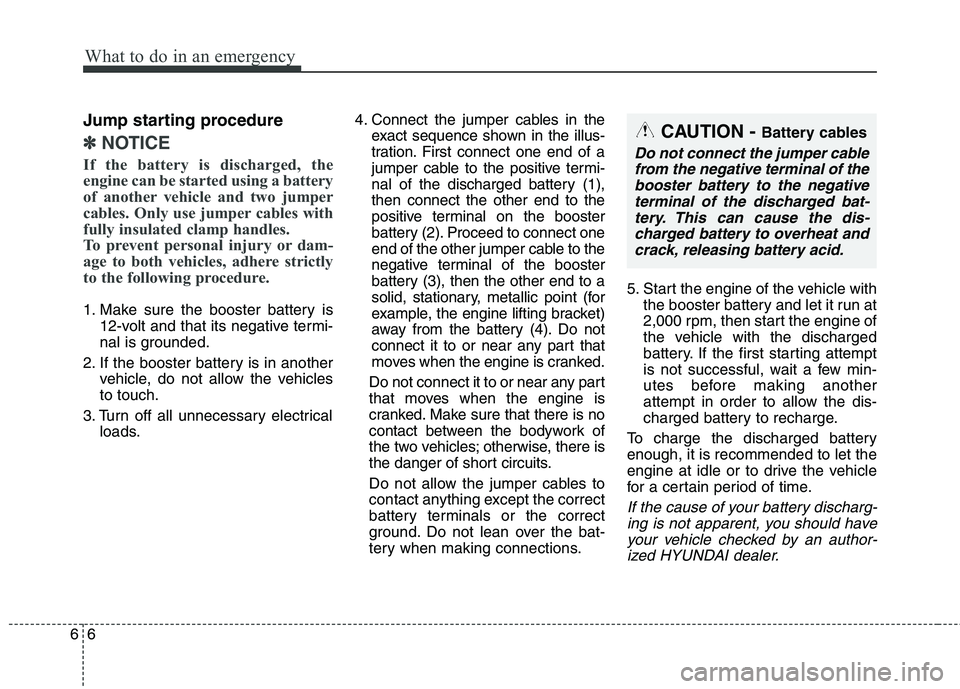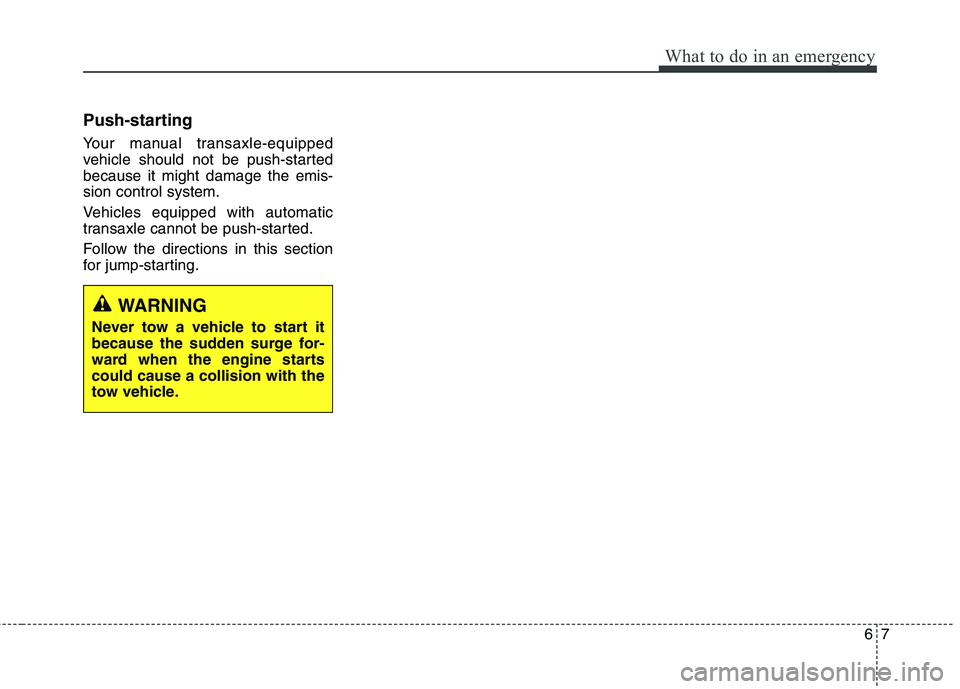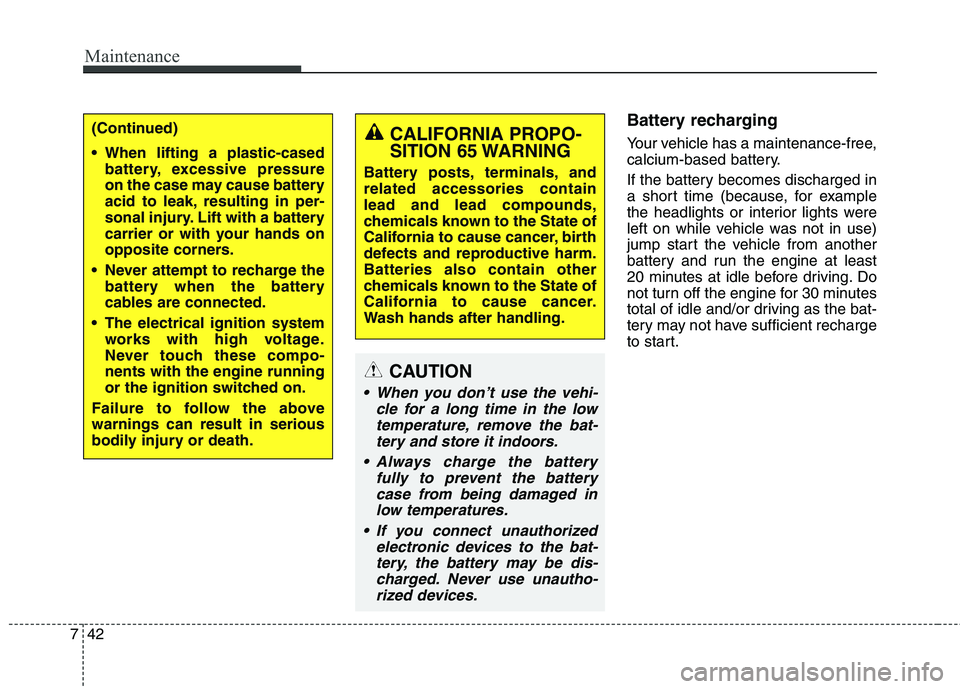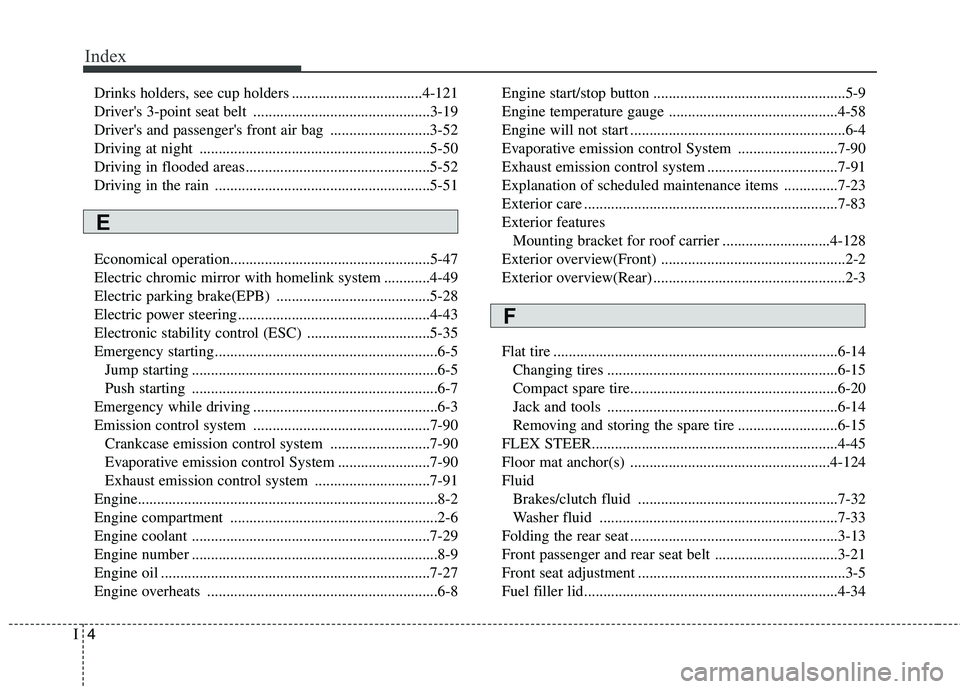2014 HYUNDAI ELANTRA GT jump start
[x] Cancel search: jump startPage 307 of 476

535
Driving your vehicle
✽ ✽
NOTICE
When you jump start your vehicle
because of a drained battery, the
engine may not run as smoothly and
the ABS warning light may turn on at
the same time. This happens because
of the low battery voltage. It does not
mean your ABS is malfunctioning.
• Do not pump your brakes!
• Have the battery recharged before
driving the vehicle.
Electronic stability control
(ESC)
The Electronic Stability control
(ESC) system is designed to stabi-
lize the vehicle during cornering
maneuvers. ESC checks where you
are steering and where the vehicle is
actually going. ESC applies the
brakes at individual wheels and inter-
venes in the engine management
system to stabilize the vehicle.
OGDE052018N
CAUTION
When you drive on a road with
poor traction, such as an icy
road, and operate your brakes
continuously, the ABS will be
active continuously and the
ABS warning light may illumi-
nate. Pull your car over to a
safe place and stop the engine.
Restart the engine. If the ABS
warning light is off, then your
ABS system is normal.
Otherwise, there may be a mal-
function with the ABS. Contact
an authorized HYUNDAI dealer
as soon as possible.
WARNING
Never drive too fast for the road
conditions or too quickly when
cornering. Electronic stability
control (ESC) will not prevent
accidents. Excessive speed in
turns, abrupt maneuvers and
hydroplaning on wet surfaces
can still result in serious acci-
dents. Only a safe and attentive
driver can prevent accidents by
avoiding maneuvers that cause
the vehicle to lose traction.
Even with ESC installed, always
follow all the normal precautions
for driving - including driving at
safe speeds for the conditions.
Page 340 of 476

What to do in an emergency
4 6
IF THE ENGINE WILL NOT START
If engine doesn't turn over or
turns over slowly
1. If your vehicle has an automatic
transaxle, be sure the shift lever is
in N (Neutral) or P (Park) and the
emergency brake is set.
2. Check the battery connections to
be sure they are clean and tight.
3. Turn on the interior light. If the light
dims or goes out when you oper-
ate the starter, the battery is dis-
charged.
4. Do not push or pull the vehicle to
start it. See instructions for "Jump
starting".
If engine turns over normally
but does not start
1. Check fuel level.
2. With the ignition switch in the LOCK
position, check all connectors at
ignition coils and spark plugs.
Reconnect any that may be discon-
nected or loose.
3. If the engine still does not start, call
an authorized HYUNDAI dealer or
seek other qualified assistance.
WARNING
If the engine will not start, do
not push or pull the vehicle to
start it. This could result in a
collision or cause other dam-
age. In addition, push or pull
starting may cause the catalytic
converter to be overloaded and
create a fire hazard.
Page 341 of 476

65
What to do in an emergency
EMERGENCY STARTING
Connect cables in numerical order
and disconnect in reverse order.
Jump starting
Jump starting can be dangerous if
done incorrectly. Therefore, to avoid
harm to yourself or damage to your
vehicle or battery, follow the jump
starting procedures. If in doubt, we
strongly recommend that you have a
competent technician or towing serv-
ice jump start your vehicle.
CAUTION
Use only a 12-volt jumper sys-
tem. You can damage a 12-volt
starting motor, ignition system,
and other electrical parts
beyond repair by use of a 24-volt
power supply (either two 12-volt
batteries in series or a 24-volt
motor generator set).
WARNING - Battery
• Keep all flames or sparks
away from the battery. The
battery produces hydrogen
gas which may explode if
exposed to flame or sparks.
If these instructions are not fol-
lowed exactly, serious personal
injury and damage to the vehi-
cle may occur! If you are not
sure how to follow this proce-
dure, seek qualified assis-
tance. Automobile batteries
contain sulfuric acid. This is
poisonous and highly corro-
sive. When jump starting, wear
protective glasses and be care-
ful not to get acid on yourself,
your clothing or on the car.
Do not attempt to jump start
the vehicle if the discharged
battery is frozen or if the elec-
trolyte level is low; the battery
may rupture or explode.
1VQA4001
Jumper
terminal
Jumper Cables
Booster
battery
Page 342 of 476

What to do in an emergency
6 6
Jump starting procedure
✽
✽
NOTICE
If the battery is discharged, the
engine can be started using a battery
of another vehicle and two jumper
cables. Only use jumper cables with
fully insulated clamp handles.
To prevent personal injury or dam-
age to both vehicles, adhere strictly
to the following procedure.
1. Make sure the booster battery is
12-volt and that its negative termi-
nal is grounded.
2. If the booster battery is in another
vehicle, do not allow the vehicles
to touch.
3. Turn off all unnecessary electrical
loads.4. Connect the jumper cables in the
exact sequence shown in the illus-
tration. First connect one end of a
jumper cable to the positive termi-
nal of the discharged battery (1),
then connect the other end to the
positive terminal on the booster
battery (2). Proceed to connect one
end of the other jumper cable to the
negative terminal of the booster
battery (3), then the other end to a
solid, stationary, metallic point (for
example, the engine lifting bracket)
away from the battery (4). Do not
connect it to or near any part that
moves when the engine is cranked.
Do not connect it to or near any part
that moves when the engine is
cranked. Make sure that there is no
contact between the bodywork of
the two vehicles; otherwise, there is
the danger of short circuits.
Do not allow the jumper cables to
contact anything except the correct
battery terminals or the correct
ground. Do not lean over the bat-
tery when making connections.5. Start the engine of the vehicle with
the booster battery and let it run at
2,000 rpm, then start the engine of
the vehicle with the discharged
battery. If the first starting attempt
is not successful, wait a few min-
utes before making another
attempt in order to allow the dis-
charged battery to recharge.
To charge the discharged battery
enough, it is recommended to let the
engine at idle or to drive the vehicle
for a certain period of time.
If the cause of your battery discharg-
ing is not apparent, you should have
your vehicle checked by an author-
ized HYUNDAI dealer.
CAUTION - Battery cables
Do not connect the jumper cable
from the negative terminal of the
booster battery to the negative
terminal of the discharged bat-
tery. This can cause the dis-
charged battery to overheat and
crack, releasing battery acid.
Page 343 of 476

67
What to do in an emergency
Push-starting
Your manual transaxle-equipped
vehicle should not be push-started
because it might damage the emis-
sion control system.
Vehicles equipped with automatic
transaxle cannot be push-started.
Follow the directions in this section
for jump-starting.
WARNING
Never tow a vehicle to start it
because the sudden surge for-
ward when the engine starts
could cause a collision with the
tow vehicle.
Page 403 of 476

Maintenance
42 7
Battery recharging
Your vehicle has a maintenance-free,
calcium-based battery.
If the battery becomes discharged in
a short time (because, for example
the headlights or interior lights were
left on while vehicle was not in use)
jump start the vehicle from another
battery and run the engine at least
20 minutes at idle before driving. Do
not turn off the engine for 30 minutes
total of idle and/or driving as the bat-
tery may not have sufficient recharge
to start.CALIFORNIA PROPO-
SITION 65 WARNING
Battery posts, terminals, and
related accessories contain
lead and lead compounds,
chemicals known to the State of
California to cause cancer, birth
defects and reproductive harm.
Batteries also contain other
chemicals known to the State of
California to cause cancer.
Wash hands after handling.
CAUTION
When you don’t use the vehi-
cle for a long time in the low
temperature, remove the bat-
tery and store it indoors.
Always charge the battery
fully to prevent the battery
case from being damaged in
low temperatures.
If you connect unauthorized
electronic devices to the bat-
tery, the battery may be dis-
charged. Never use unautho-
rized devices.
(Continued)
When lifting a plastic-cased
battery, excessive pressure
on the case may cause battery
acid to leak, resulting in per-
sonal injury. Lift with a battery
carrier or with your hands on
opposite corners.
Never attempt to recharge the
battery when the battery
cables are connected.
The electrical ignition system
works with high voltage.
Never touch these compo-
nents with the engine running
or the ignition switched on.
Failure to follow the above
warnings can result in serious
bodily injury or death.
Page 470 of 476

Index
4I
Drinks holders, see cup holders ..................................4-121
Driver's 3-point seat belt ..............................................3-19
Driver's and passenger's front air bag ..........................3-52
Driving at night ............................................................5-50
Driving in flooded areas................................................5-52
Driving in the rain ........................................................5-51
Economical operation....................................................5-47
Electric chromic mirror with homelink system ............4-49
Electric parking brake(EPB) ........................................5-28
Electric power steering..................................................4-43
Electronic stability control (ESC) ................................5-35
Emergency starting..........................................................6-5
Jump starting ................................................................6-5
Push starting ................................................................6-7
Emergency while driving ................................................6-3
Emission control system ..............................................7-90
Crankcase emission control system ..........................7-90
Evaporative emission control System ........................7-90
Exhaust emission control system ..............................7-91
Engine..............................................................................8-2
Engine compartment ......................................................2-6
Engine coolant ..............................................................7-29
Engine number ................................................................8-9
Engine oil ......................................................................7-27
Engine overheats ............................................................6-8Engine start/stop button ..................................................5-9
Engine temperature gauge ............................................4-58
Engine will not start ........................................................6-4
Evaporative emission control System ..........................7-90
Exhaust emission control system ..................................7-91
Explanation of scheduled maintenance items ..............7-23
Exterior care ..................................................................7-83
Exterior features
Mounting bracket for roof carrier ............................4-128
Exterior overview(Front) ................................................2-2
Exterior overview(Rear) ..................................................2-3
Flat tire ..........................................................................6-14
Changing tires ............................................................6-15
Compact spare tire......................................................6-20
Jack and tools ............................................................6-14
Removing and storing the spare tire ..........................6-15
FLEX STEER................................................................4-45
Floor mat anchor(s) ....................................................4-124
Fluid
Brakes/clutch fluid ....................................................7-32
Washer fluid ..............................................................7-33
Folding the rear seat ......................................................3-13
Front passenger and rear seat belt ................................3-21
Front seat adjustment ......................................................3-5
Fuel filler lid..................................................................4-34
F
E
Page 472 of 476

Index
6I
Floor mat anchor(s) ..................................................4-124
Power outlet..............................................................4-123
Sunvisor ....................................................................4-122
Interior light ..................................................................4-92
Interior overview ............................................................2-4
Jack and tools ................................................................6-14
Jump starting ..................................................................6-5
Key ..................................................................................5-6
Keys ................................................................................4-4
Label
Air bag warning label ................................................3-66
Refrigerant label ..........................................................8-9
Tire sidewall labeling ................................................7-50
Tire specification and pressure label ............................8-9
Vehicle certification label ............................................8-8
LCD display warning ....................................................4-78
Light bulbs ....................................................................7-71
Lighting ........................................................................4-83
Battery saver function ................................................4-83Daytime running light ................................................4-84
Headlamp delay ..........................................................4-83
Headlamp welcome function......................................4-84
Lower anchor ................................................................3-36
Lubricants and capacities ................................................8-5
Luggage net ................................................................4-120
Maintenance
Explanation of scheduled maintenance items ............7-23
Maintenance services ..................................................7-4
Maintenance under severe usage conditions ..............7-21
Normal maintenance schedule ....................................7-9
Scheduled maintenance service....................................7-8
Tire maintenance ........................................................7-49
Maintenance schedule ....................................................7-8
Maintenance under severe usage conditions ..............7-21
Normal maintenance schedule ....................................7-9
Maintenance services ......................................................7-3
Manual climate control system ....................................4-97
Air conditioning ......................................................4-102
Climate control air filter ..........................................4-105
Heating and air conditioning ......................................4-98
Manual transaxle ..........................................................5-14
Manual transaxle shift indicator....................................4-60
Mirrors ..........................................................................4-48
Blue link center ..........................................................4-48
M
K
L
J